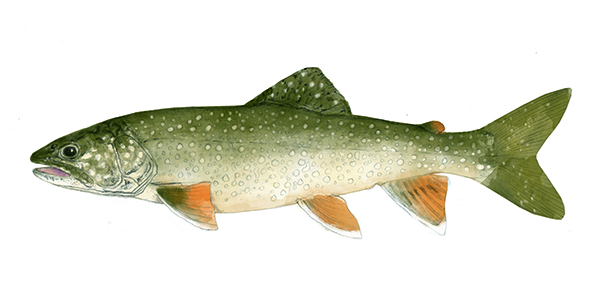Home → Fish & Wildlife → Fisheries → Species Information → Lake Trout (Togue)
Lake Trout (Togue)

Common Name: Lake Trout, Togue
Other Names: Laker, Grey Trout, Mackinaw
Scientific Name: Salvelinus namaycush
Origin: Native
Adult Size: In most waters, lake trout commonly reach lengths of 18 to 24 inches and weights of 2 to 4 pounds. They are among the longest lived and largest freshwater game fish, often living 20 years or more and attaining sizes of over 30 inches and 10 pounds.
Identification: Lake trout have a typical trout-shaped body covered with creamy white spots on a background of bronze, dark brown, or green. Their coloration can resemble brook trout but lack the colorful reds spots with blue halos of a brook trout. Another distinguishing feature of lake trout is a deeply forked tail as opposed to the square tail of the brook trout.
Diet: Lake trout are voracious and adaptable feeders, foraging on a wide variety of aquatic organisms. In some lakes they are almost exclusively plankton feeders and in others they feed on a variety of prey from crayfish to smelts to white perch. Consequently, these prolific eaters can grow quite large.
Fishing Tips: Lake trout are deep dwellers that prefer very cold water year-round. In the spring and fall, lake trout can be caught close to shore by casting or trolling using streamer flies, minnows, or lures.
In the summer, the best method of fishing for them is trolling with lead core line or downriggers using minnows or copper, white, or silver lures. In late June, July, and August you'll typically catch lake trout at depths below 45 feet.
Ice fishing for lake trout can be quite productive in water depths between 10 and 100 feet. In this case, you'll want to use smelt, shiners, suckers, or silver, white, or copper jigs.
Interesting Facts:
- Lake trout are the largest native freshwater fish in Maine with the state record being 39.2 pounds from Richardson Lake.
- With their large size and agility comes the ability to feed on large mobile prey such as gamefish like landlocked salmon, brook trout, whitefish, cusk, white perch, and bass.
- They are also cannibalistic and will feed on smaller fish of their own species.
Management: In some lake trout waters across the state wild populations are overly abundant – too high to sustain satisfactory growth and condition to produce quality fisheries for anglers. On these waters regulations are usually liberalized to allow for increased harvest in order to maintain balance with forage populations. Conversely, other lakes and ponds with more limited habitat and recruitment, produce fewer numbers of lake trout and are managed for larger quality size fish. Regulations on these waters typically include low bag limits, high minimum length limits, or no-harvest slot limits.